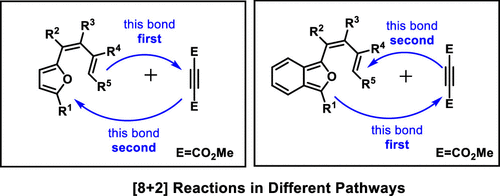当前位置:
X-MOL 学术
›
J. Org. Chem.
›
论文详情
Our official English website, www.x-mol.net, welcomes your
feedback! (Note: you will need to create a separate account there.)
Density Functional Theory Study of Mechanisms of [8 + 2] Cycloadditions of Dienylfurans/Dienylisobenzofurans with DMAD
The Journal of Organic Chemistry ( IF 3.3 ) Pub Date : 2021-01-05 , DOI: 10.1021/acs.joc.0c01960 Qi Cui 1 , Yuanyuan Chen 1 , James W. Herndon 2 , Zhi-Xiang Yu 1
The Journal of Organic Chemistry ( IF 3.3 ) Pub Date : 2021-01-05 , DOI: 10.1021/acs.joc.0c01960 Qi Cui 1 , Yuanyuan Chen 1 , James W. Herndon 2 , Zhi-Xiang Yu 1
Affiliation

|
The mechanisms of [8 + 2] cycloaddition reactions between dienylfurans/dienylisobenzofurans and the activated alkyne, DMAD (dimethyl acetylenedicarboxylate), have been investigated by DFT calculations. The former [8 + 2] reaction is stepwise, starting from attack of the diene substituent on furan, not the furyl moiety in dienylfurans, to DMAD to give a diradical intermediate, which then undergoes ring closure to form the second bond between DMAD and the furan moiety, generating the final [8 + 2] cycloadducts. In contrast, the latter [8 + 2] reaction starts from [4 + 2] cycloaddition of the diene in the furan ring of dienylisobenzofurans toward DMAD, followed by the rate-determining stepwise [1,5]-vinyl shift, forming the [8 + 2] products. The different mechanisms of [8 + 2] reactions are attributed to the facts that for dienylfurans, the reactive diene part is the diene substituent on furan, but in the case of dienylisobenzofurans, it is the diene in the furan ring (its reaction with DMAD to generate an aromatic benzene ring is the driving force for this regiochemistry). Consequently, the [8 + 2] reactions begin with the reaction of the most reactive part of tetraene (either the diene substituent on furan for dienylfurans or the diene in the furan ring for dienylisobenzofurans) with DMAD. FMO analysis and kinetic study have been carried out to gain more information of the reaction mechanisms. Two [8 + 2] reactions of dienylisobenzofurans with different substituents toward DMAD have also been further analyzed by DFT calculations in this paper.
中文翻译:

密度泛函理论研究DMAD [8 + 2]环二烯呋喃/二烯基异苯并呋喃的加成机理
通过DFT计算研究了二烯基呋喃/二烯基异苯并呋喃与活化炔烃DMAD(乙酰二羧酸二甲酯)之间[8 + 2]环加成反应的机理。前者[8 + 2]反应是逐步地从dienylfurans呋喃,而不是呋喃基部分二烯取代基的攻击开始,到DMAD,得到二价基团的中间体,然后经历闭环作用,生成DMAD和之间的第二个键呋喃部分,生成最终的[8 + 2]环加合物。相反,后者的[8 + 2]反应从二烯基异苯并呋喃的呋喃环中的二烯向DMAD的[4 + 2]环加成开始,然后逐步确定[1,5]-乙烯基位移的速率,形成[ 8 + 2]产品。[8 + 2]反应的不同机理归因于以下事实:对于二烯基呋喃,反应二烯部分是呋喃二烯取代基,但在dienylisobenzofurans的情况下,它是在呋喃环的二烯(它与DMAD反应以生成芳族苯环是该区域选择性的驱动力)。因此,[8 + 2]反应开始于四烯的最具反应性的部分(二烯基呋喃的呋喃上的二烯取代基或二烯基异苯并呋喃的呋喃环中的二烯)与DMAD的反应。进行了FMO分析和动力学研究,以获取更多有关反应机理的信息。本文还通过DFT计算进一步分析了具有不同取代基的二烯基异苯并呋喃的两个[8 + 2]反应。它是在呋喃环的二烯(它与DMAD,以产生芳族苯环是此区域化学驱动力反应)。因此,[8 + 2]反应开始于四烯的最具反应性的部分(二烯基呋喃的呋喃上的二烯取代基或二烯基异苯并呋喃的呋喃环中的二烯)与DMAD的反应。进行了FMO分析和动力学研究,以获取更多有关反应机理的信息。本文还通过DFT计算进一步分析了具有不同取代基的二烯基异苯并呋喃的两个[8 + 2]反应。它是在呋喃环的二烯(它与DMAD,以产生芳族苯环是此区域化学驱动力反应)。因此,[8 + 2]反应开始于四烯的最具反应性的部分(二烯基呋喃的呋喃上的二烯取代基或二烯基异苯并呋喃的呋喃环中的二烯)与DMAD的反应。进行了FMO分析和动力学研究,以获取更多有关反应机理的信息。本文还通过DFT计算进一步分析了具有不同取代基的二烯基异苯并呋喃的两个[8 + 2]反应。[8 + 2]反应始于四烯的最具反应性的部分(对于二烯基呋喃,呋喃上的二烯取代基,对于二烯基异苯并呋喃,在呋喃环中的二烯)与DMAD反应。进行了FMO分析和动力学研究,以获取更多有关反应机理的信息。本文还通过DFT计算进一步分析了具有不同取代基的二烯基异苯并呋喃的两个[8 + 2]反应。[8 + 2]反应始于四烯的最具反应性的部分(对于二烯基呋喃,呋喃上的二烯取代基,对于二烯基异苯并呋喃,在呋喃环中的二烯)与DMAD反应。进行了FMO分析和动力学研究,以获取更多有关反应机理的信息。本文还通过DFT计算进一步分析了具有不同取代基的二烯基异苯并呋喃的两个[8 + 2]反应。
更新日期:2021-01-16
中文翻译:

密度泛函理论研究DMAD [8 + 2]环二烯呋喃/二烯基异苯并呋喃的加成机理
通过DFT计算研究了二烯基呋喃/二烯基异苯并呋喃与活化炔烃DMAD(乙酰二羧酸二甲酯)之间[8 + 2]环加成反应的机理。前者[8 + 2]反应是逐步地从dienylfurans呋喃,而不是呋喃基部分二烯取代基的攻击开始,到DMAD,得到二价基团的中间体,然后经历闭环作用,生成DMAD和之间的第二个键呋喃部分,生成最终的[8 + 2]环加合物。相反,后者的[8 + 2]反应从二烯基异苯并呋喃的呋喃环中的二烯向DMAD的[4 + 2]环加成开始,然后逐步确定[1,5]-乙烯基位移的速率,形成[ 8 + 2]产品。[8 + 2]反应的不同机理归因于以下事实:对于二烯基呋喃,反应二烯部分是呋喃二烯取代基,但在dienylisobenzofurans的情况下,它是在呋喃环的二烯(它与DMAD反应以生成芳族苯环是该区域选择性的驱动力)。因此,[8 + 2]反应开始于四烯的最具反应性的部分(二烯基呋喃的呋喃上的二烯取代基或二烯基异苯并呋喃的呋喃环中的二烯)与DMAD的反应。进行了FMO分析和动力学研究,以获取更多有关反应机理的信息。本文还通过DFT计算进一步分析了具有不同取代基的二烯基异苯并呋喃的两个[8 + 2]反应。它是在呋喃环的二烯(它与DMAD,以产生芳族苯环是此区域化学驱动力反应)。因此,[8 + 2]反应开始于四烯的最具反应性的部分(二烯基呋喃的呋喃上的二烯取代基或二烯基异苯并呋喃的呋喃环中的二烯)与DMAD的反应。进行了FMO分析和动力学研究,以获取更多有关反应机理的信息。本文还通过DFT计算进一步分析了具有不同取代基的二烯基异苯并呋喃的两个[8 + 2]反应。它是在呋喃环的二烯(它与DMAD,以产生芳族苯环是此区域化学驱动力反应)。因此,[8 + 2]反应开始于四烯的最具反应性的部分(二烯基呋喃的呋喃上的二烯取代基或二烯基异苯并呋喃的呋喃环中的二烯)与DMAD的反应。进行了FMO分析和动力学研究,以获取更多有关反应机理的信息。本文还通过DFT计算进一步分析了具有不同取代基的二烯基异苯并呋喃的两个[8 + 2]反应。[8 + 2]反应始于四烯的最具反应性的部分(对于二烯基呋喃,呋喃上的二烯取代基,对于二烯基异苯并呋喃,在呋喃环中的二烯)与DMAD反应。进行了FMO分析和动力学研究,以获取更多有关反应机理的信息。本文还通过DFT计算进一步分析了具有不同取代基的二烯基异苯并呋喃的两个[8 + 2]反应。[8 + 2]反应始于四烯的最具反应性的部分(对于二烯基呋喃,呋喃上的二烯取代基,对于二烯基异苯并呋喃,在呋喃环中的二烯)与DMAD反应。进行了FMO分析和动力学研究,以获取更多有关反应机理的信息。本文还通过DFT计算进一步分析了具有不同取代基的二烯基异苯并呋喃的两个[8 + 2]反应。











































 京公网安备 11010802027423号
京公网安备 11010802027423号